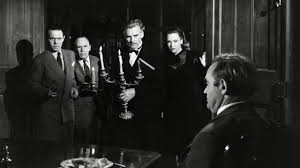The movie And Then There Were None (1945) made some interesting artistic choices. The original title of the book by Agatha Christie was evidently something racist about black people. The title itself was taken from an 1869 minstrel song that plays a major part in the book and movie. When the book was released in America in January 1940 the title was changed to “And Then There Were None.” This still had a focus on the song, which had been changed to a racist song about Native Americans, without the racist book title. The title of the book stayed the same in the UK until 1985. America kept their title the same until American Pocket Book Paperbacks used the racist Native American version of the poem for the title of the book in publications from 1964-1986 (“And Then There Were None” 2023). In the films more recent release the island name and the poem (which have matched in all versions) was changed to Soldier Island, the poem in turn became “10 Little Soldiers.” While these might seem trivial changes Alison Light said these changes did make a difference. “In its initial form it could be relied upon automatically to conjure up a thrilling ‘otherness’, a place where revelations about the ‘dark side’ of the English would be appropriate … Christie’s location is both more domesticated and privatized, taking for granted the construction of racial fears woven into psychic life as early as the nursery. If her story suggests how easy it is to play upon such fears, it is also a reminder of how intimately tied they are to sources of pleasure and enjoyment.” (Light, Alison, 2013, 99). (Stein, Sadie. 2016) In this sense, the very title of the book/movie and the cover art are making changes that impact how the story is told. I would say that Alison Light’s work shows a historical significance that is no longer relevant in todays culture and that continuing to focus on certain racist titles and themes could be detrimental to the work being done to atone for past sins (Hofmann, Sudie. “Rethinking Agatha Christie.” 2022.).
To focus on the 1945 version of the film the very first artistic choice we see is that the guests arrive via boat in complete silence. This was likely a design choice based on the difficulty of micing over a motor boat, but could also reference the lack of knowledge and trust that each individual has with the other guests. This does differ from the book where it starts with Mrs. Claythorne’s (June Duprez) history, a carriage ride, and then the boat. During the carriage ride and the boat trip (which is evidently easier in the book), the characters are able to discuss who invited them and the oddities of their coming to the island. In the film, when they arrive on the island, they discover that none of them know their host, a Mr. U.N. Owen, but he knows friends of theirs. The exception to this is the newly hired secretary Mrs. Claythorne.
At dinner the centerpiece is 10 figurines that reminds Mrs. Claythorne of the nursery rhyme that ends up being their death sentences. After dinner Rogers (Richard Haydn), the butler, plays a record that announces every guest has committed a murder. The guests question Rogers only to discover that he and his wife were only recently hired. That the same captain who had brought them to the island had brought this record and a note saying to play it after dinner. This movie had to have been part of the inspiration in the movie Clue (1985). The description gave me Clue vibes, going to a dinner, and the reveal after dinner. Clue being one of my favorite movies of all time, I couldn’t miss a chance to watch this movie.
The black and white film allows for lots of play in shadows and light. At one point the power goes out and there is only flickering candle light for the scenes and it definitely lent a hostile air to those scenes of the movie. As the guests are killed one by one, a figurine from the center piece breaks. The guests know one of them must be the murderer. But which already accused of the crime has decided to make this party their playground.
I very much enjoyed watching this film, it was eerie without being violent or going to the height of psychological thriller. I’m definitely interested in reading the book its based on. I’m also interested in watching the 2016 remake of the film. The book that inspired this movie remains Agatha Christie’s best selling book of all time.
Bibliography
Christie, Agatha, and Dudley Nichols. And Then There Were None. USA: Popular Pictures, Inc. and Twentieth Century-Fox Film Corp, 1945. https://www.amazon.com/Then-There-Were-None/dp/B0945X6Z3C/ref=tmm_aiv_swatch_0?_encoding=UTF8&qid=1702130719&sr=8-1.
“And Then There Were None.” 2023. Wikipedia. December 4, 2023. https://en.wikipedia.org/wiki/And_Then_There_Were_None#:~:text=It%20was%20first%20published%20in.
Christie, Agatha. 10 Little Niggers. London: Collins / The Crime Club, 1939.
Hofmann, Sudie, and Sudie Hofmann (shofmann@stcloudstate.edu) teaches at St. Cloud State University in Minnesota. “Rethinking Agatha Christie.” Rethinking Schools, November 17, 2022. https://rethinkingschools.org/articles/rethinking-agatha-christie/#:~:text=And%20Then%20There%20Were%20Some%20Changes&text=The%20play%20is%20now%20officially,been%20changed%20to%20Soldier%20Island.
Landis, John, Jonathan Lynn, and Anthony E Pratt. Clue. DVD. USA: Paramount Pictures, 1985.
Light, Alison. Forever England: Femininity, Literature and Conservatism Between the Wars. Books.Google.Com. Routledge, 2013. https://books.google.com/books?id=tU2AAAAAQBAJ&pg=PA99&lpg=PA99&dq=to+conjure+up+a+thrilling+%E2%80%98otherness%E2%80%99,&source=bl&ots=AC-gpfNlCB&sig=p6s3gQLUN3uD2nuXCMtdxQ5qrE0&hl=en&sa=X&ved=0ahUKEwiwq4Wv1uHKAhWCRCYKHSW6BVMQ6AEIHTAA#v=onepage&q=to%20conjure%20up%20a%20thrilling%20%E2%80%98otherness%E2%80%99%2C&f=false.
Stein, Sadie. “The History Behind Agatha Christie’s ‘And Then There Were None.’” The Paris Review. Accessed December 8, 2023. https://www.theparisreview.org/blog/2016/02/05/mystery/#:~:text=Perhaps%20you’ve%20seen%20the,version%20of%20the%20minstrel%20song.).


